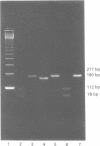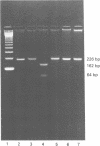Abstract
We describe a new point mutation in the SRY gene of a Chinese XY female with gonadal dysgenesis (Swyer syndrome). Using the double stranded DNA cycle sequencing method, a single nucleotide substitution of G-->A was identified at codon 113 of the patient's SRY gene, resulting in a conservative amino acid change from alanine (A) to threonine (T) at a residue that lies within the putative DNA binding motif. With this mutation, one MnlI recognition site is abolished and a new BsmAI site is present in the DNA sequence of the SRY gene; therefore, it is easily detected by analysis of the digestion of the amplified SRY DNA fragment on an electrophoretic agarose gel. In situ hybridisation to the XY female's chromosomes showed that her mutant SRY gene was indeed located on the short arm of her Y chromosome. The SRY mutation in the XY female reported here occurred de novo, as sequence analysis showed that it was not present in her father or other family members.
Full text
PDF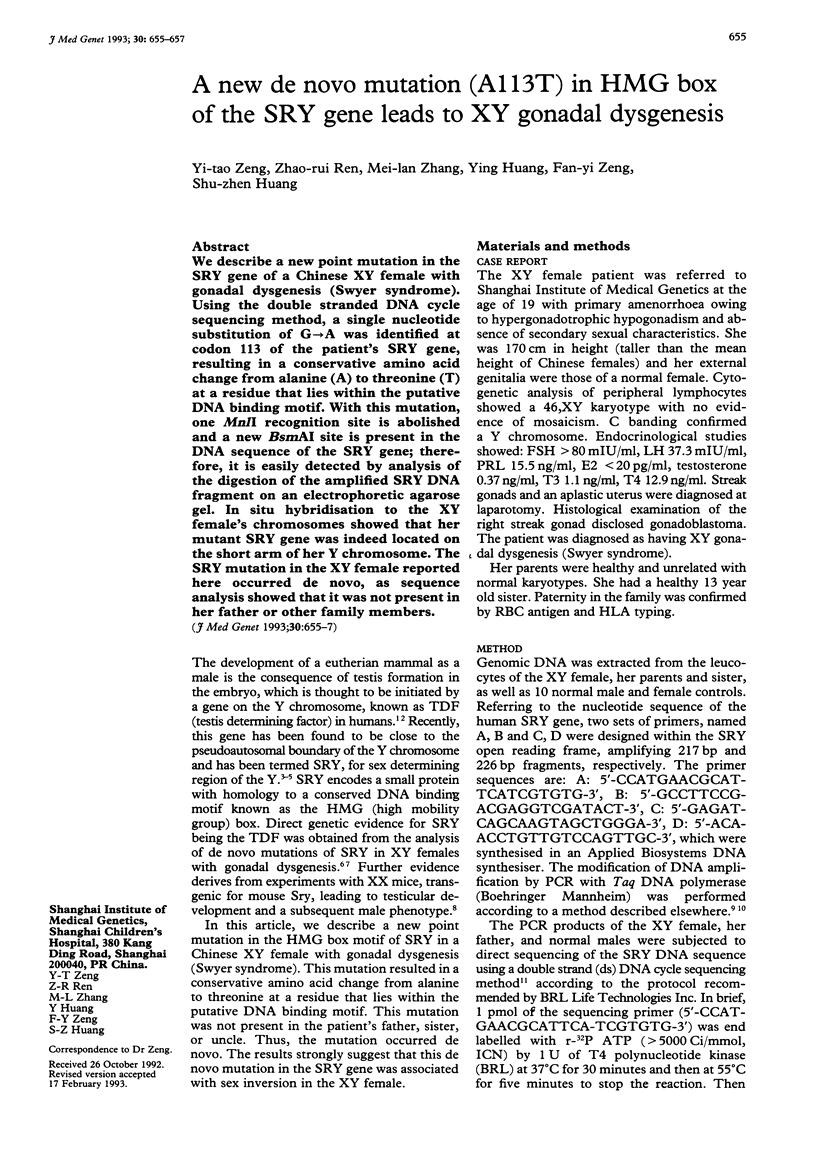
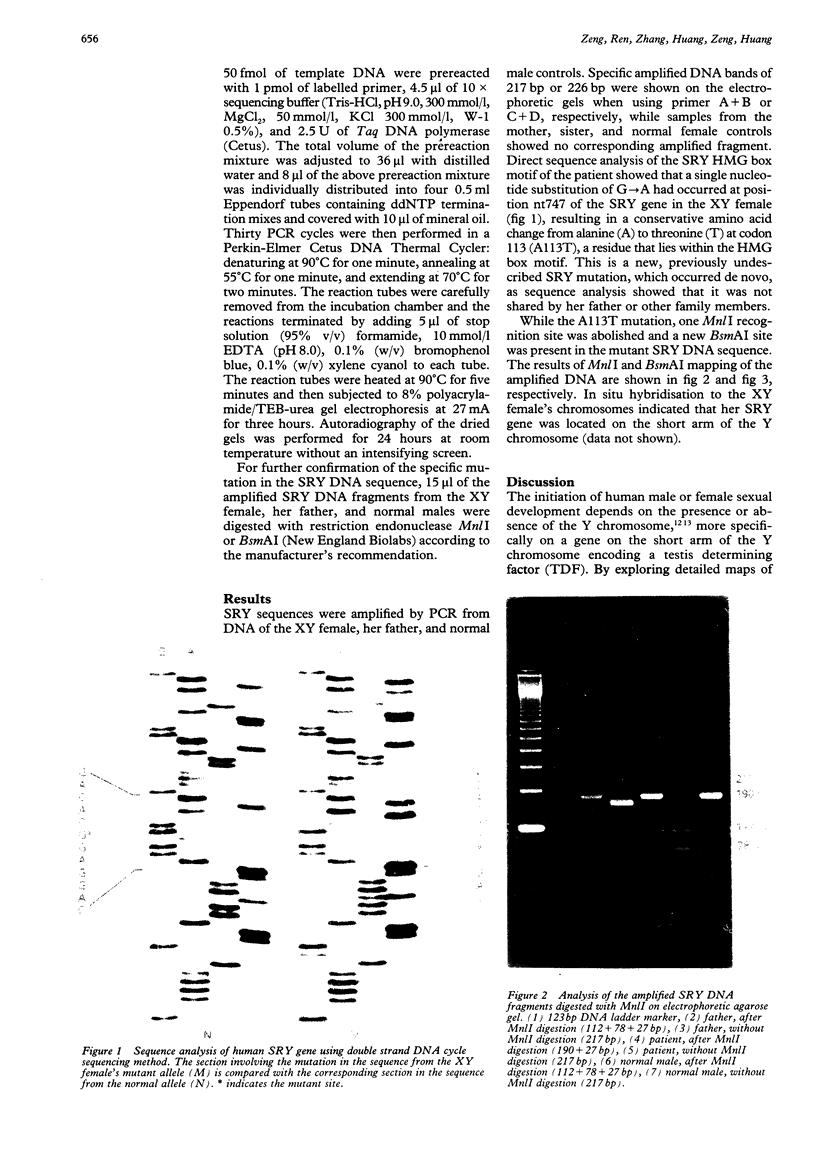
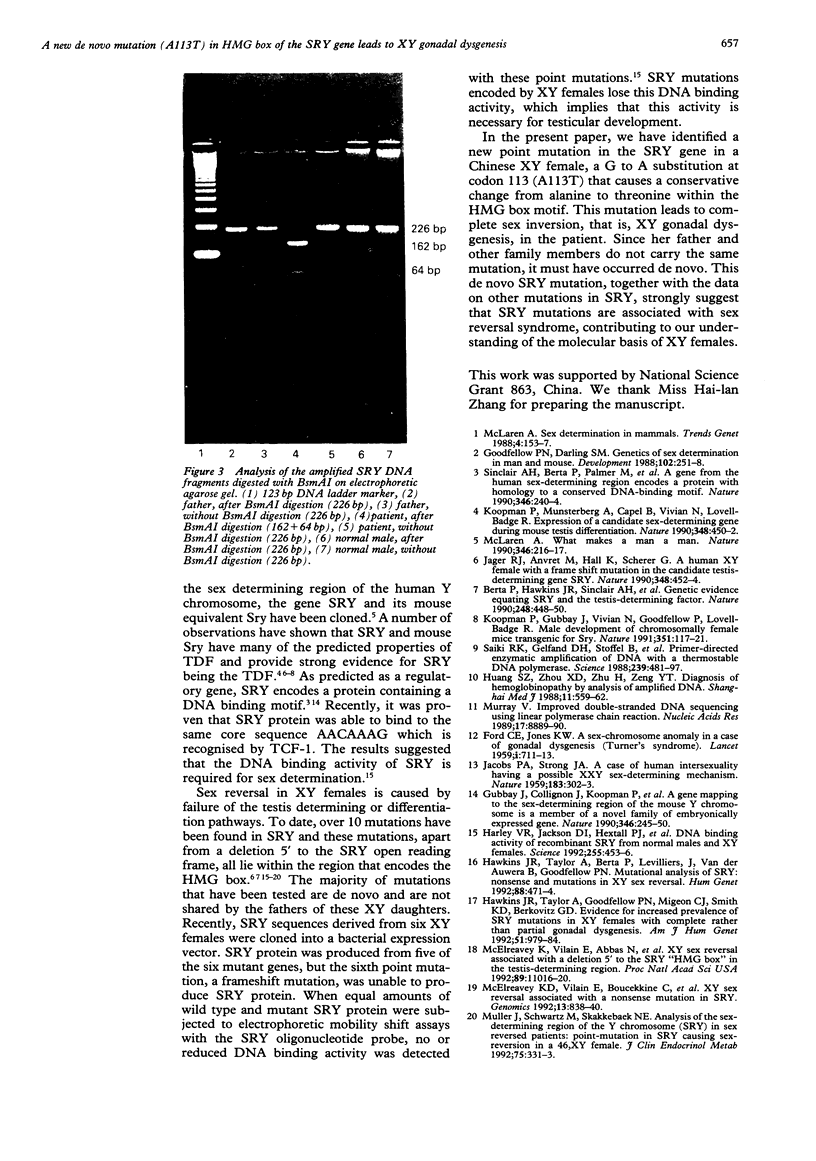
Images in this article
Selected References
These references are in PubMed. This may not be the complete list of references from this article.
- Berta P., Hawkins J. R., Sinclair A. H., Taylor A., Griffiths B. L., Goodfellow P. N., Fellous M. Genetic evidence equating SRY and the testis-determining factor. Nature. 1990 Nov 29;348(6300):448–450. doi: 10.1038/348448A0. [DOI] [PubMed] [Google Scholar]
- CHRISTIE B. G. Intra-articular prednisolone 21: phosphate; a clinical trial. Lancet. 1959 Jan 10;1(7063):71–72. doi: 10.1016/s0140-6736(59)91138-9. [DOI] [PubMed] [Google Scholar]
- Goodfellow P. N., Darling S. M. Genetics of sex determination in man and mouse. Development. 1988 Feb;102(2):251–258. doi: 10.1242/dev.102.2.251. [DOI] [PubMed] [Google Scholar]
- Gubbay J., Collignon J., Koopman P., Capel B., Economou A., Münsterberg A., Vivian N., Goodfellow P., Lovell-Badge R. A gene mapping to the sex-determining region of the mouse Y chromosome is a member of a novel family of embryonically expressed genes. Nature. 1990 Jul 19;346(6281):245–250. doi: 10.1038/346245a0. [DOI] [PubMed] [Google Scholar]
- Harley V. R., Jackson D. I., Hextall P. J., Hawkins J. R., Berkovitz G. D., Sockanathan S., Lovell-Badge R., Goodfellow P. N. DNA binding activity of recombinant SRY from normal males and XY females. Science. 1992 Jan 24;255(5043):453–456. doi: 10.1126/science.1734522. [DOI] [PubMed] [Google Scholar]
- Hawkins J. R., Taylor A., Berta P., Levilliers J., Van der Auwera B., Goodfellow P. N. Mutational analysis of SRY: nonsense and missense mutations in XY sex reversal. Hum Genet. 1992 Feb;88(4):471–474. doi: 10.1007/BF00215684. [DOI] [PubMed] [Google Scholar]
- Hawkins J. R., Taylor A., Goodfellow P. N., Migeon C. J., Smith K. D., Berkovitz G. D. Evidence for increased prevalence of SRY mutations in XY females with complete rather than partial gonadal dysgenesis. Am J Hum Genet. 1992 Nov;51(5):979–984. [PMC free article] [PubMed] [Google Scholar]
- JACOBS P. A., STRONG J. A. A case of human intersexuality having a possible XXY sex-determining mechanism. Nature. 1959 Jan 31;183(4657):302–303. doi: 10.1038/183302a0. [DOI] [PubMed] [Google Scholar]
- Jäger R. J., Anvret M., Hall K., Scherer G. A human XY female with a frame shift mutation in the candidate testis-determining gene SRY. Nature. 1990 Nov 29;348(6300):452–454. doi: 10.1038/348452a0. [DOI] [PubMed] [Google Scholar]
- Koopman P., Gubbay J., Vivian N., Goodfellow P., Lovell-Badge R. Male development of chromosomally female mice transgenic for Sry. Nature. 1991 May 9;351(6322):117–121. doi: 10.1038/351117a0. [DOI] [PubMed] [Google Scholar]
- Koopman P., Münsterberg A., Capel B., Vivian N., Lovell-Badge R. Expression of a candidate sex-determining gene during mouse testis differentiation. Nature. 1990 Nov 29;348(6300):450–452. doi: 10.1038/348450a0. [DOI] [PubMed] [Google Scholar]
- McElreavey K. D., Vilain E., Boucekkine C., Vidaud M., Jaubert F., Richaud F., Fellous M. XY sex reversal associated with a nonsense mutation in SRY. Genomics. 1992 Jul;13(3):838–840. doi: 10.1016/0888-7543(92)90164-n. [DOI] [PubMed] [Google Scholar]
- McElreavy K., Vilain E., Abbas N., Costa J. M., Souleyreau N., Kucheria K., Boucekkine C., Thibaud E., Brauner R., Flamant F. XY sex reversal associated with a deletion 5' to the SRY "HMG box" in the testis-determining region. Proc Natl Acad Sci U S A. 1992 Nov 15;89(22):11016–11020. doi: 10.1073/pnas.89.22.11016. [DOI] [PMC free article] [PubMed] [Google Scholar]
- McLaren A. Sex determination in mammals. Trends Genet. 1988 Jun;4(6):153–157. doi: 10.1016/0168-9525(88)90020-0. [DOI] [PubMed] [Google Scholar]
- McLaren A. Sex determination. What makes a man a man? Nature. 1990 Jul 19;346(6281):216–217. doi: 10.1038/346216a0. [DOI] [PubMed] [Google Scholar]
- Murray V. Improved double-stranded DNA sequencing using the linear polymerase chain reaction. Nucleic Acids Res. 1989 Nov 11;17(21):8889–8889. doi: 10.1093/nar/17.21.8889. [DOI] [PMC free article] [PubMed] [Google Scholar]
- Müller J., Schwartz M., Skakkebaek N. E. Analysis of the sex-determining region of the Y chromosome (SRY) in sex reversed patients: point-mutation in SRY causing sex-reversion in a 46,XY female. J Clin Endocrinol Metab. 1992 Jul;75(1):331–333. doi: 10.1210/jcem.75.1.1619028. [DOI] [PubMed] [Google Scholar]
- Sinclair A. H., Berta P., Palmer M. S., Hawkins J. R., Griffiths B. L., Smith M. J., Foster J. W., Frischauf A. M., Lovell-Badge R., Goodfellow P. N. A gene from the human sex-determining region encodes a protein with homology to a conserved DNA-binding motif. Nature. 1990 Jul 19;346(6281):240–244. doi: 10.1038/346240a0. [DOI] [PubMed] [Google Scholar]



